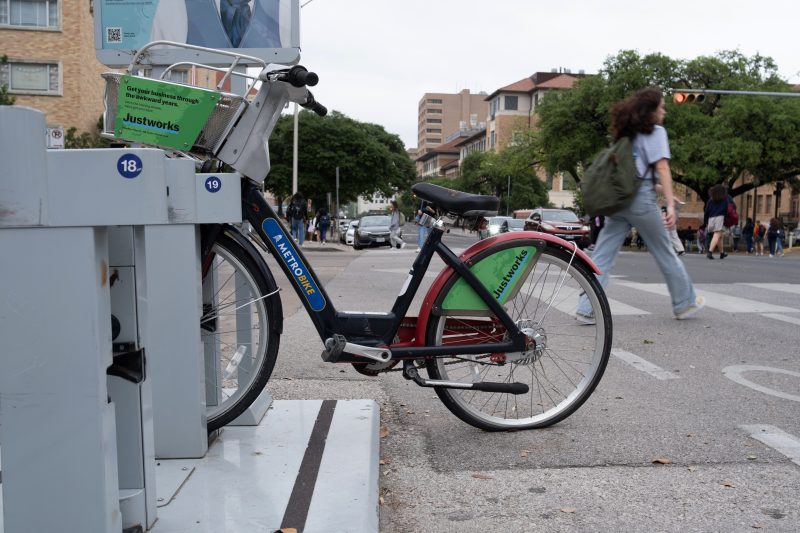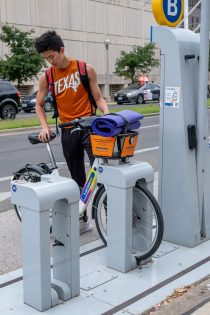Austin Aims to Increase E-Bike Ridership
By Jinpeng Li
Reporting Texas

An e-bike rider navigates a turn in the West Campus area near the University of Texas at Austin on April 18, 2023. The city of Austin is trying to incentivize ridership by offering rebates. Rush Skinner/Reporting Texas
As Arti Patel, 25, rode her e-bike through the brisk Austin twilight on a Wednesday in April, she couldn’t help but smile. At that moment she felt no regret for ditching her car and spending $3,200 on an eclectic bicycle.
Patel is a research assistant at a small economic consulting firm. She rides her E-bike, which she bought in October 2022, from her home in East Austin to her job in Central Austin and for errands and social outings. In situations where a car is necessary, Patel borrows her boyfriend’s Toyota Prius. He uses the car sparingly since he bought his own e-bike in April.
Few Austin residents use e-bikes for most of their transportation needs, but the city wants to change that. In January the city doubled down on an already existing Austin Energy rebate program, which provides refunds of up to $600 to customers who purchase new light electric vehicles, such as e-bikes and electric scooters, from authorized local dealers.
The revised rebate program received 250 applications between Jan. 1 and March 8, an Austin Energy spokesperson told Reporting Texas.

An e-bike awaits riders on the University of Texas at Austin campus in April. Sales of the bikes have increased since a rebate was doubled for customers who purchased them. Rush Skinner/Reporting Texas
“Since the rebate program took effect, we have seen a clear increase in sales, selling over hundreds of e-bikes per month in Austin,” said Jessica Mitchell, the sales specialist at Mod Bike, one of the few U.S.-based e-bike manufacturers. Patel bought her bike directly from Mod Bike.
“The application process is easy. Customers simply need to provide their account numbers, and we have all the necessary information that Austin Energy requires,” Mitchell said. “It takes between six to eight weeks to receive the rebate.”
With escalating prices for fuel, insurance, and parking, e-bike advocates say the vehicles are one of the best ways to reduce car usage.
Austin resident Alexander Cassell, 31, uses his Onyx RCR e-bike several times a week for quick trips. He carries it in his car. “My electric devices allow me to park further away from my destination and more conveniently to downtown locations, then travel (the) last mile via e-bike,” said Cassell, who manages the Austin E-bike Facebook group.
Recent technological advancements have made e-bikes a viable alternative to vehicles. Depending on the terrain and level of electric assistance, e-bikes can travel between 20 to 100 miles on a single charge.
Manufacturers are investing in creating e-bikes and accessories that can replace cars, such as the Mod Easy Sidecar that attaches to an e-bike and can be used to transport children or pets.

Luke Hisao, co-owner of Electric Surf Co., discusses his experience with the e-bike industry at his shop in Austin on April 18, 2023. Rush Skinner/Reporting Texas
Luke Hisao gave up his job in finance a year ago to open Electric Surf Co., an e-bike retail shop in South Austin.
“When people own and ride them, they discover a new sense of freedom as they can explore new areas of Austin,” Hisao said. He also organizes weekly ride events on Wednesday nights, attracting people with different types of vehicles including electric one wheels, electric skateboards and e-bikes.
Patel said e-bikes make it easier for her and her e-biking friends to explore all corners of Austin. “I never hesitate to go to Zilker Park and Barton Springs on weekends because I don’t have to circle around for parking for 30 minutes,” Patel said. “The feeling of biking through town on a beautiful day is also pretty priceless to me.”
Cassell frequently rides 30 miles with friends in the morning. “I’ve put about 2,000 miles on it in the last year,” he said, showing his ride records to Reporting Texas. “It’s not an exaggeration to say that I ride it everywhere.”

E-bike riders come in all ages but people with hip and knee issues are especially drawn to them, say bike shop employees. Rush Skinner/ Reporting Texas
E-bike buyers are of all ages, Electric Surf Co. and Mod Bike employees told Reporting Texas. “A lot of elderly people who have hip and knee issues can’t ride (traditional bikes) as well anymore,” Mitchell said.
“It can enable seniors to age in place in their homes when they can no longer drive, or prefer to give up the household expense of a privately owned automobile,” said Robin Stallings, the executive director for BikeTexas, a bike-advocacy organization. “Also, increased physical activity from e-bike use can improve health.”
E-bikes are not cheap.
“Our entry-level e-bike is $1,000, while higher-quality options go up to about $3,000,” Hisao said. “Prices can even reach a staggering $10,000.”
As the e-bike rebate program expands, the city hopes to reach out to historically underrepresented communities. The program offers higher incentives for eligible low-income customers, such as a $300 rebate for purchasing a $1,000 e-bike.
“Due to their financial constraints, people in temporary or long-term financial difficulty may be unable to afford one (but) the average annual costs of owning and maintaining a car are triple the cost of an e-bike,” said Jack Flagler, the marketing supervisor of City of Austin.
In the Austin Bicycle Draft Plan 2023, the city has set a goal of increasing the e-bike rebate program to over 5,000 rebates annually.
“A key part of that equity effort is increasing awareness and incentives for low-income communities so that they are more likely to adopt this technology,” said Matt Mitchell, Austin Energy spokesperson, in an email to Reporting Texas.
Leo Cao is a 33-year-old Ph.D. student at the University of Texas at Austin who regularly commutes on his e-bike. Having lived for five years in the Netherlands, which boasts perhaps the world’s best cycling infrastructure, Leo believes that the government needs to take more action to support e-bike riders if the city wants to become truly bicycle-friendly.
“We need to redesign the city for humans, not cars,” Cao said.
The draft plan’s top infrastructure recommendation is to expand the All Ages and Abilities (AAA) Bicycle network, which was established in 2014 and designed to accommodate higher speed e-bikes. The network currently spans over 1,200 miles, and the estimated cost of building out the remaining planned network is $1 billion.